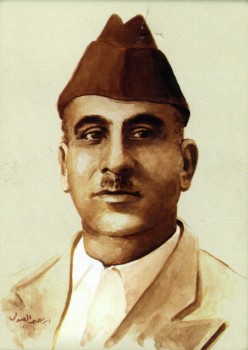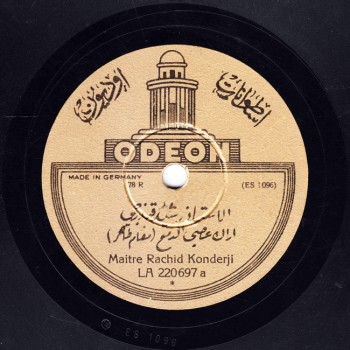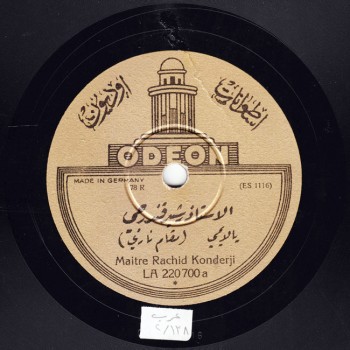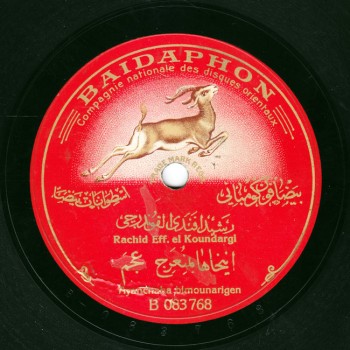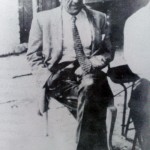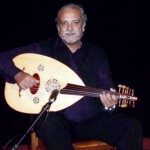The Arab Music Archiving and Research foundation (AMAR), in collaboration with the Sharjah Art Foundation (SAF), presents “Min al-Tārīkh”.
Dear listeners,
Welcome to a new episode of “Min al-Tārīkh”.
Today, we will be talking with our guest Mr. Husayn al-A‘zami about Rashīd al-Qundargī, a reference in Iraqi maqām and the author of a famous ṭarīqa in the art of maqām ‘irāqī.
Mr. Husayn, tell us about Rashīd al-Qundargī’s life.
Rashīd al-Qundargī was born in 1886 and died in 1945.
When I was the director of the House of Iraqi maqām –and the Houses of Iraqi maqām in the other Governorates–, I invited the House’s Advisory Committee and we agreed on artistic nicknames/titles for some of the 20th century Iraqi maqām singers. Our project was approved by the Ministry of Culture and Rashīd al-Qundargī was given the title of “Pioneer of perfect maqām singing in the 20th century”…
(♩)
This is the title he was granted.
Perfect indeed.
We granted him this title because he deserves it.
To my knowledge –knowing that information is usually tossed around and altered–, it is said that he was of Kurdish origin and that his mother was an Arab.
The name “Qundargī” refers to a profession not to a place.
Yes… This is a very good remark Mr. Mustafa. In Iraq, a qundargī is a shoemaker, not a cobbler –called iskāfī. It is important to note that Rashīd al-Qundargī was a shoemaker not a cobbler.
The great muṭrib Rashīd al-Qundargī absorbed the quintessence of the ancient singing ṭarīqa-s existing at the time and whose roots dated back to the 19th century, notably his master Aḥmad al-Zaydān’s ṭarīqa that Rashīd witnessed, experiencing its depth and analysing its shapes and its contents, drawing later his unique singing ṭarīqa through which he reached the classical peak of all the ṭarīqa-s that preceded him. This was a major turning point for listeners as to their appreciation of performance aesthetics.
In this work, Rashīd al-Qundargī turned over the period’s performance standards, crowning the legend of his era after the bases of his solid ṭarīqa took shape and influenced numerous singers who came after him and adopted his ṭarīqa.
All that has been written about him is not enough to convey the completeness of his ṭarīqa as to the uṣūl in creating and structuring tunes: he was a great designer of tunes and a talented engineer who tended towards perfection.
His significant production in Iraqi maqām recording greatly influenced his period’s singers as well as those who followed.
I highlighted an important issue in my book on Rashīd al-Qundargī that must be mentioned because people pass it around with very little precision: it is said that he was given alcohol –or something else– to drink, which ruined his voice when he was at his best. So he recorded numerous discs in a zīr voice, i.e. a fake/artificial voice.
Muḥammad al-Qubbāngī –officially, Rashīd was fifteen years older than al-Qubbāngī. Yet, in a fast era, fifteen years are considered to be a long period– witnessed the recording era when he was at his best, while Rashīd al-Qundargī’s voice was quite damaged by then. Still, he made these recordings in this fake voice called zīr in Iraq, a term understood in all Arabic dialects.
Zīr also refers to the high octave zīr string in the ‘ūd.
Yes… There is a shared characteristic with Rashīd al-Qundargī’s voice…
(♩)
Strangely, despite this, Rashīd al-Qundargī significantly influenced these milieus at the time, and was followed by many singers.
My uncle ‘Abd al-Khāliq was among those greatly influenced by Rashīd al-Qundargī and often sang his maqām-s. In fact, most of my uncle’s generation preferred Rashīd al-Qundargī to Muḥammad al-Qubbāngī.
Maybe because the latter did not preserve the form.
Exactly. Muḥammad al-Qubbāngī delivered an altered performance, even on stage. He brought too many changes…
(♩)
Before ending this episode, I would like to point out some remarks:
First, we have listened to three maqām-s, each one of them in a bastah. The first maqām, i.e. the maqām ‘ajam, was recorded by Baidaphon. The second maqām, i.e. the maqām nārī, was recorded by Odeon. The third maqām, i.e. the maqām ṭāhir to which he sang Abū Firās al-Ḥamdānī’s famous qaṣīda “Arāka ‘aṣiyy al-dam‘ ” and that we just heard, was recorded by Baidaphon and is among the first matrixes that featured the name of Rashīd al-Qundargī, early in 1924. He later made an electrical recording with Odeon around 1929. He may have made other recordings with other record companies as well as with the Iraqi Radio, but until today only Baidaphon’s and Odeon’s recordings have reached AMAR.
Dear listeners, with these remarks we reach the end of today’s episode of “Min al-Tārīkh”.
We thank Mr. Husayn al-A‘zami.
We will meet again in a new episode to resume our discussion about the disciples of al-ṭarīqa al-Qundargiyya, i.e. Rashīd al-Qundargī’s ṭarīqa.
“Min al-Tārīkh” is brought to you by Mustafa Said.
- 221 – Zakariyya Ahmed – 12 (1/9/2022)
- 220 – Zakariyya Ahmed – 11 (1/9/2022)
- 219 – Zakariyya Ahmed – 10 (11/25/2021)
- 218 – Zakariyya Ahmed – 9 (10/26/2021)
- 217 – Zakariyya Ahmed – 8 (9/24/2021)
- 216 – Zakariyya Ahmed – 7 (9/4/2021)
- 215 – Zakariyya Ahmed – 6 (8/28/2021)
- 214 – Zakariyya Ahmed – 5 (8/6/2021)
- 213 – Zakariyya Ahmed – 4 (6/26/2021)
- 212 – Zakariyya Ahmed – 3 (5/27/2021)
- 211 – Zakariyya Ahmed – 2 (5/1/2021)
- 210 – Zakariyya Ahmed – 1 (4/28/2021)
- 209 – W-al-Lāhi lā astaṭī‘u ṣaddak 2 (4/6/2017)
- 208 – W-al-Lāhi lā astaṭī‘u ṣaddak 1 (3/30/2017)
- 207 – Bashraf qarah baṭāq 7 (3/23/2017)

